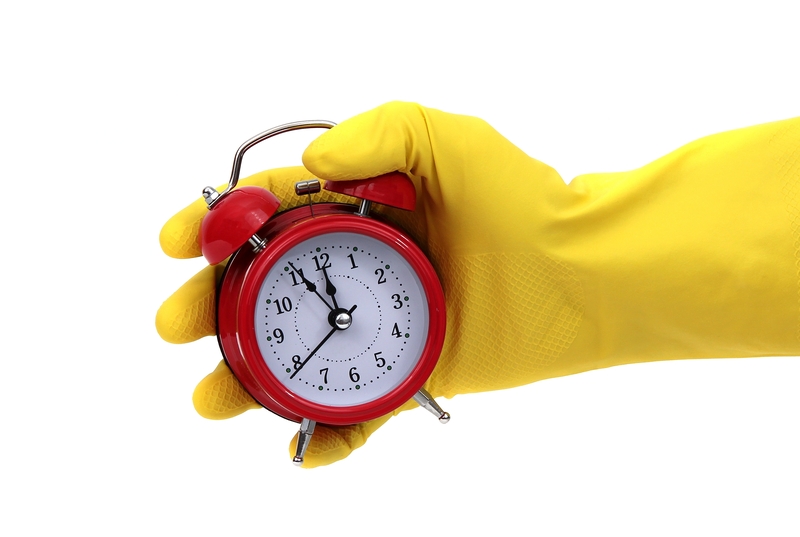Revitalize Your Home by Cleaning Curtains Properly
Posted on 22/09/2025
Revitalize Your Home by Cleaning Curtains Properly
If you're looking to transform the ambiance of your living space, don't overlook your curtains! Revitalizing your home by cleaning curtains properly is one of the most effective, affordable, and often neglected ways to achieve a fresher, brighter atmosphere. Curtains work not only as decorative fabric panels but also as dust and allergen collectors, making routine maintenance essential for home hygiene and aesthetics.

Why Cleaning Curtains is Vital for a Fresh Home
Your curtains do more than provide privacy and complement your decor. Over time, they absorb dust, pet dander, pollen, smoke, and odors from your home's environment. This buildup can make them look dull and even worse, harbor potential allergens that affect your health. Regular and proper curtain cleaning ensures these issues are kept at bay, providing you with multiple benefits:
- Brighter, more inviting rooms
- Healthier indoor air quality
- Prolonged curtain lifespan
- Prevention of stains and material degradation
- Reduced accumulation of allergens and odors
How Often Should You Clean Your Curtains?
The optimal curtain cleaning frequency depends mainly on factors such as your home's location, presence of pets, smokers, and family allergies. For instance, a curtain in a smoker's home or on a window frequently open to a busy street will acquire dirt much faster. In general, experts recommend:
- Light vacuuming or shaking: every 1-2 weeks
- Full cleaning or washing: every 3-6 months
- Deep professional cleaning: once a year, for special fabrics or heavy soiling
Regular attention keeps fabric fresh and extends curtain life while helping revitalize your interiors.
The Ultimate Guide to Cleaning Curtains Properly
Step 1: Identify Your Curtain Fabric
The first--and most critical step--in cleaning your curtains properly is identifying the fabric's type and cleaning requirements. Curtains are made from a variety of materials such as:
- Cotton and linen: Durable and often machine-washable
- Polyester and synthetics: Easy-care and resilient
- Silk and velvet: Delicate and may require dry cleaning
- Wool or blends: Might shrink or distort if not handled correctly
Always check the manufacturer's label for instructions! If in doubt, consult a professional or test a small hidden area first before proceeding.
Step 2: Remove Dust and Debris Regularly
Before any deep cleaning, start by removing surface dust. This step keeps grime from turning into more stubborn stains:
- Use a vacuum cleaner with an upholstery attachment to gently clean the curtain while it's still hanging. Work from top to bottom!
- For lighter fabrics, carefully shake them outside to dislodge dust and small particles.
- Use a lint roller or brush on delicate materials to avoid damage.
This simple routine goes a long way in maintaining curtain freshness and preventing embedded dirt particles.
Step 3: Spot Clean Stains Promptly
Spills and marks are inevitable. To prevent permanent discoloration or weakening of the fibers, it's critical to spot clean stains immediately:
- Blot the stain with a clean, damp cloth. Don't rub, as that can spread the stain!
- Use a gentle fabric cleaner or mild soap solution suited for your curtain type.
- Rinse with another clean, damp cloth and allow to air dry.
For oil, ink, or wine stains, consider consulting a professional to protect the fabric structure.
Step 4: Choosing Between Machine, Hand, and Dry Cleaning
The best cleaning method depends on your curtain material and construction:
-
Machine Washing
- Suitable for most *cotton, polyester, and linen* curtains.
- Remove all hooks, rings, or trims.
- Use a gentle cycle with cold water and mild detergent.
- Wash similar colors together to prevent color transfer.
-
Hand Washing
- Best for delicate fabrics or lace curtains.
- Fill a tub or large basin with cool water and mild soap.
- Gently agitate the fabric for a few minutes, rinse well, and do not wring out excessively.
-
Dry Cleaning
- Required for velvet, silk, wool, or lined curtains.
- Always follow label instructions and use a reputable dry cleaner.
Step 5: Dry Your Curtains Properly
Proper drying is essential to avoid shrinking, wrinkling, or fabric distortion. After washing:
- Hang curtains to air dry on a sturdy line or rod. Spread out the fabric for even drying.
- Avoid direct sunlight for silk or bright colors to prevent fading.
- If using a dryer, choose the lowest heat setting and remove when slightly damp to reduce wrinkles.
- Iron curtains on the reverse side if allowed for a crisp finish.
Step 6: Maintain and Freshen Curtains Between Washes
Between deep cleans, keep your curtains looking and smelling fresh with these simple habits:
- Mist lightly with fabric freshener or diluted essential oil spray
- Open windows often for natural ventilation
- Vacuum regularly, especially if you have pets or smoke indoors
This ongoing care not only removes everyday dust but also keeps your home revitalized and inviting throughout the year.
Professional Curtain Cleaning vs. DIY: What's Best?
For particularly valuable or delicate draperies, consider the benefits of professional curtain cleaning:
- Expertise: Professionals identify the best cleaning method for specialty fabrics.
- Equipment: Industrial-grade machines handle heavy or awkward curtain sizes.
- Convenience: Saves time and ensures thorough results, especially for wool, velvet, or lined curtains.
- Preservation: Reduces risk of shrinkage, color running, or fabric damage.
However, for standard, washable fabrics, DIY curtain cleaning is highly effective, economical, and easily manageable with the right steps and care.
Tips for Keeping Curtains Looking New Longer
- Rotate curtains periodically to avoid uneven sunlight exposure and fading.
- Keep windows clean to minimize dirt transfer to curtain surfaces.
- Use tiebacks to reduce handling and wear of the fabric edges.
- Address stains and odors immediately for easier removal.
- Replace or clean curtain linings for an extra layer of protection.
Eco-Friendly and Allergy-Safe Curtain Cleaning Solutions
Revitalize your home by cleaning curtains properly with green, allergen-conscious options:
- Use gentle, biodegradable detergents instead of harsh chemicals.
- Try adding a half cup of white vinegar to your wash cycle for natural deodorization and brightening.
- Sprinkle baking soda on fabric before vacuuming to neutralize earthy odors.
- Opt for dry steam cleaning for a chemical-free refresh that also kills dust mites.
These simple swaps are not only planet-friendly but also keep sensitive individuals more comfortable at home.
Common Mistakes to Avoid When Cleaning Curtains
To ensure your efforts pay off, steer clear of these frequent pitfalls:
- Ignoring care labels. Curtain fabrics often require specific cleaning methods.
- Overloading the washing machine. This can lead to uneven cleaning and excessive wrinkling.
- Using hot water or harsh chemicals on delicate materials, risking shrinkage or damage.
- Not removing hooks, rings, or trims, which can snag or rust during washing.
- Drying in direct sunlight, which can cause irreparable fading especially on delicate or colored fabrics.
Always take your time, read the label, and assess the material before starting any cleaning process.
The Impact of Clean Curtains on Your Home's Ambiance
Clean curtains do more than simply revitalize your home's appearance. By removing built-up dust and allergens, you:
- Allow more natural light to flow freely through your space, enhancing brightness and mood.
- Reduce the presence of allergens, creating a healthier environment--especially crucial for children or those with respiratory issues.
- Contribute to a tidy, fragrant, and welcoming atmosphere that makes guests feel at home.
- Protect your investment by prolonging the life and beauty of your window treatments.

Frequently Asked Questions about Curtain Cleaning
Can I wash blackout or lined curtains?
Many blackout curtains must be dry-cleaned or gently hand-washed due to their special linings, which can degrade or separate in a washing machine. Always consult the care label for specific instructions.
Is it safe to use a steamer on all curtains?
A fabric steamer works well on most synthetics and cotton but may cause spots or shrinkage on silk or velvet. Try steaming a hidden section first before exposing the entire panel.
How do I prevent curtains from shrinking?
Always use cool water, gentle cycles, and avoid high heat during drying. Air-drying is the safest option, and never wring out delicate drapes.
Can I clean curtains without removing them?
Yes! Regular vacuuming and occasional spot cleaning keep curtains tidy between deep washes. However, routine removal and thorough cleaning are the only ways to eliminate deeply embedded contaminants.
Conclusion: Breathe New Life Into Your Home by Cleaning Curtains Properly
Making a commitment to revitalize your home by cleaning curtains regularly and correctly pays off in beauty, hygiene, and comfort. From better air quality to a vibrant, lasting aesthetic, the advantages are hard to overstate. Whether you decide to tackle the job yourself or turn to professionals, proper care and attention to your window treatments can transform your living space into a fresher, brighter, and more inviting home.
Don't let your curtains become tired or overlooked accessories. Invest the time or seek expert help to keep them clean, and enjoy the revitalizing effects throughout your whole house!




